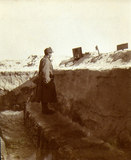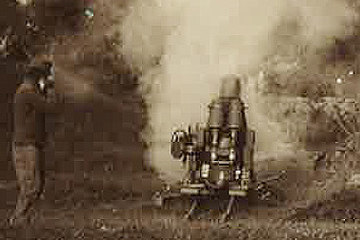-

Artillery barracks on Monte Pana, Dolomite Front, photograph, winter 1917
Copyright: Sammlung Frauennachlässe, Institut für Geschichte der Universität Wien
Partner: Sammlung Frauennachlässe, Institut für Geschichte der Universität Wien -

“Majdan 2nd line emplacement”, Eastern Front, extract from Fritz Ortlieb's war photo album
Copyright: Sammlung Frauennachlässe, Institut für Geschichte der Universität Wien/Fotografie: Angelika Spangel
Partner: Sammlung Frauennachlässe, Institut für Geschichte der Universität Wien -

“Observation post” on the Eastern Front, around 1916/1917, extract from Fritz Ortlieb's war photo album
Copyright: Sammlung Frauennachlässe, Institut für Geschichte der Universität Wien/Fotografie: Angelika Spangel
Partner: Sammlung Frauennachlässe, Institut für Geschichte der Universität Wien -

Signals with spotlights on Köderhöhe, photo, 1915
Copyright: Inge Hundt
-

Soldiers telephoning on Köderhöhe, photo, 1915
Copyright: Inge Hundt
To protect the troops against weather conditions and the foe, the aim was to build shelters that were as well-constructed and as practically appointed as possible. In practice, this ambition could be realised only with limitations; all depended on the scene of military operations and climatic/geographical conditions and whether the troops were moving, thus advancing or retreating, or were stationary in the “Stellungskrieg”, in trench warfare.
The range of accommodation included sleeping outside and in tent camps, billeting in buildings abandoned – thus empty – by the local population through flight or deportation, the construction of barrack settlements, and cavern systems far up in the summits and even glaciers of the Southwestern Front.
Responsible for building trenches and other positions were mainly specially trained units such as pioneers or sappers, but infantry soldiers also joined in the work. Entire billeting camps were set up as well as trenches, approach trenches and connection passages. They consisted of barracks for troopers, officers’ huts, washhouses, latrines and buildings for storing food, ammunition, tools and building materials. Furthermore diverse communication devices were constructed, telephone, telegraph stations, designed to guarantee transfer of notifications and information. This involved laying telephone cables and setting up so-called field telegraphs. Further communication media included carrier pigeons, also flags, flare cartridges, megaphones and alarm bells, mainly used for alert and alarm signals.
To ensure the safety of the troops, field watches and listening posts were deployed, on duty day and night in all weathers. It was their task to observe and identify hostile movements and attacks and to give immediate alarm. The watch was to be relieved “every four to eight hours” according to Isabelle Brandauer; in particularly bad weather the intervals were shorter. On Col di Lana, for instance, the relief was planned “every half hour” in bad weather. The following report by an unknown writer in 1916 demonstrates how exposed the sentries were to weather conditions, especially in winter:
“(…) The one suffering the most was the sentry exposed to driving snow on the bare plateau. He had to withstand with all his strength the force of the wind, and whirling snowflakes covered his form in no time. The sentries were able to keep to their posts out there only a short while before being relieved. All this was nothing more than a security measure – observation didn’t enter into it. You couldn’t see further than three or four paces in front of you. It often happened that the post being relieved had to be directly shovelled out of the snow.”
In contrast to the flatland camps, in the high altitude positions huts were built onto the rock faces and caverns driven into the rocks with detonations and drills. The latter shelters were considered particularly important, since they protected the men from artillery attacks and shrapnel.
Where to build such a camp depended primarily on the local conditions and tactical considerations: ideally, it should not be seen by enemy units, not situated too near rivers or ponds and should be protected as far as possible from falling rocks, mudslides and avalanches in winter. The shelters and complexes were principally in a continual state of work-in-progress; repairs, extensions and improvements formed part of the troops’ everyday tasks.
In performing the construction work the men were firstly greatly dependent on local timber supplies and stocks of other necessary resources. Secondly, they had to take into account the paths upon which the building material was to be transported and above all mastered. Thousands of feet in altitude had to be overcome, especially in the high-altitude mountain positions, possible only with great exertions using cableways, bridle paths and carriers.
Translation: Abigail Prohaska
Brandauer, Isabelle: Menschenmaterial Soldat. Alltagsleben an der Dolomitenfront im Ersten Weltkrieg 1915–1917, Innsbruck 2007
Hämmerle, Christa: Soldaten, in: Labanca, Nicola/Überegger, Oswald (Hrsg.): Krieg in den Alpen. Österreich-Ungarn und Italien im Krieg, Wien/Köln/Weimar 2014, im Druck
Wachtler, Michael, Giacomel, Paolo, Obwegs, Günther: Dolomiten. Krieg, Tod und Leid, Bozen 2004
Quotes:
„Responsible for building trenches …“: Brandauer, Isabelle: Menschenmaterial Soldat. Alltagsleben an der Dolomitenfront im Ersten Weltkrieg 1915–1917, Innsbruck 2007, 182
„every four to eight hours …“: quoted from: Brandauer, Isabelle: Menschenmaterial Soldat. Alltagsleben an der Dolomitenfront im Ersten Weltkrieg 1915–1917, Innsbruck 2007, 42
„every half hour“ : quoted from: Brandauer, Isabelle: Menschenmaterial Soldat. Alltagsleben an der Dolomitenfront im Ersten Weltkrieg 1915–1917, Innsbruck 2007, 42
„(…) The one suffering the most, ...“: Kriegsarchiv (KA –War Archive), Neue Feldakten (NFA – New Field Documents), IR. 59. Kt. 569, Winter at 8,000 feet in the region of the 3 Zinnen. Experience report of an unknown author from 1916, quoted from: Brandauer, Isabelle: Menschenmaterial Soldat. Alltagsleben an der Dolomitenfront im Ersten Weltkrieg 1915–1917, Innsbruck 2007, 226













